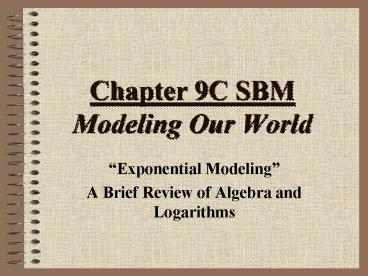Chapter 9C SBM Modeling Our World PowerPoint PPT Presentation
1 / 18
Title: Chapter 9C SBM Modeling Our World
1
Chapter 9C SBMModeling Our World
- Exponential Modeling
- A Brief Review of Algebra and Logarithms
2
What is 9C all about?
- In 9C, we will investigate the exponential
function and some of its many applications in
mathematical models. - This exponential modeling is a quantity that has
a constant growth rate.
3
Exponential Functions
- An exponential function grows (or decays) by the
same relative amount per unit time. - For any quantity Q growing exponentially with a
fractional growth rate r (which r is positive)
equals - Where t time Q Value of quantity at
time t - Qo initial value of quantity (t 0) r
fractional growth rate for quantity
Q Qo X (1 r)t
4
Did you forget Logarithms???
- Did you forget logarithms and all the wonderful
concepts from chapter 8. - If so, go back to chapter 8, especially lesson 8B
and review those concepts.
5
Algebra with Logarithms Review (also on pg. 526)
- Solve for x in the equation 3x 100.
log10 3x log10 100
xlog10 3 log10 100
log10 100
x
log10 3
2
x
4.1918
0.4771212
6
Graphing Exponential Growth Functions...
- The easiest way to graph an exponential growth
function is to use points corresponding to
several doubling times. - We start with the point (0, Q0) that represents
the initial value at t 0. - For exponentially growing quantities, we know
that one doubling the value of Q is 2Q0. After
2 doublings (Q is 4Q0). - And so on See table 9.17a on pg. 528
7
Graphing Exponential Decay Functions...
- The easiest way to graph an exponential decay
function is to use points corresponding to
several half lives. - We start with the point (0, Q0) that represents
the initial value at t 0. - For exponentially decaying quantities, we know
that one half life of value Q is ½ Q0. After 2
doublings (Q is ¼ Q0). - And so on See table 9.17b on pg. 528
8
Alternative Forms of the Exponential Function
- Our general equation for the exponential function
is Q Qo X (1 r)t - This contains a growth rate, not doubling time or
half-life chapter 8. - See the next slide for alternate formulas
- See pg. 529 if you want to know how
9
Alternate forms of the Exponential Function
- With Doubling Time
- With Half-Life
Q Qo X 2 t / T double
Q Qo X (1/2) t / T half
10
Example One
- The average price of a home in a certain town was
86,000 in 1990, but home prices have been
falling by 4 per year. Create an exponential
function of the form Q Qo X (1 r)t to model
this situation. - Be sure to clearly identify each of the variables
in your function. Then make a graph of the
exponential function.
11
Example One(Answer)
- Answer Q 86,000(0.96)t where Q is the average
home price (in thousands of ) and t is the
number of years after 1990.
12
Example Two
- In 1995, the enrollment at a certain university
was 2400 students. If the enrollment increases by
11 per year, what will the enrollment be in the
year 2008? - 2400 (1.11)13 9320 students.
13
Example Three
- Suppose that poaching reduces the population of
an endangered animal by 12 per year. Further,
suppose that when the population of this animal
falls below 45, its extinction is inevitable
(owing to the lack of reproductive options
without severe in-breeding). - If the current population of this animal is 1400,
in how many years will it face extinction?
14
Example Three(Answer)
Q Qo X (1 r)t
- 45 1400 (1.0 0.12)t
- 45 1400 (0.88)t
- 45/1400 (0.88)t
- 0.0321428571 (0.88)t
log 0.0321428571
26.89 years
log 0.88
15
Example Four
- A fossilized bone contains about 62 of its
original carbon-14. - How old is the bone? (The half-life of carbon-14
is about 5700 years.)
Q Qo X (1/2) t / T half
Q Qo
(1/2) t / T half
16
Example Four(Answer)
- Since we know there is 62 remaining, we can
substitute that for Q/Qo. And then interchange
the two sides, we get - (1/2) t / 5700 0.62
- log10 (1/2) t / 5700 log10
0.62 - (t / 5700) X log10 (1/2) log10 0.62
- and by doing some algebra, we get
- t 5700 X
log 0.62
3931 years
log (1/2)
17
Examples, Examples, Examples
- Please refer to the Seven (7) examples in the
lesson while working on your homework. - They will help you tremendously
18
Homework
- 9C 1 5, 13 21
- Some of these are very complicated, so refer to
your notes and book - Extra Credit (separate sheet) 26 a - d
- HW Quiz over Ch. 9 next block
- Test over 9A-9C next block (45 min)
- Dont forget your 3 x 5 card

